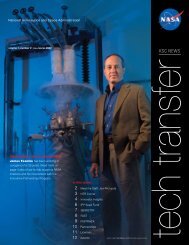2006-2007 - Kennedy Space Center Technology Transfer Office
2006-2007 - Kennedy Space Center Technology Transfer Office
2006-2007 - Kennedy Space Center Technology Transfer Office
- No tags were found...
You also want an ePaper? Increase the reach of your titles
YUMPU automatically turns print PDFs into web optimized ePapers that Google loves.
Sixty-four–Channel Inline Cable TesterFaults in wiring are a serious concern for the aerospace and aeronautics (commercial,Wire/CableInspection and military, and civil) industries. A number of accidents have occurred because faulty wiringRepair created shorts or opens that resulted in the loss of control of the aircraft or because arcingled to fires and explosions. Some of these accidents have resulted in the massive loss of lives(such as in the TWA Flight 800 accident). Circuits on the <strong>Space</strong> Shuttle have also failed because offaulty insulation on wiring. STS-93 lost power when a primary power circuit in one engine failedand a second engine had a backup power circuit fault. Cables are usually tested on the groundafter the crew reports a fault encountered during flight. Often such failures result from vibrationand cannot be replicated while the aircraft is stationary. It is therefore important to monitor faultswhile the aircraft is in operation, when cables are more likely to fail.Work is in progress to develop a cable fault tester capable of monitoring up to 64 individual wiressimultaneously. Faults can be monitored either inline or offline. In the inline mode of operation,the monitoring is performed without disturbing the normal operation of the wires under test.That is, the operations are performed unintrusively and are essentially undetectable for the testsignal levels are below the noise floor. A cable can be monitored several times per second in theoffline mode and once a second in the inline mode. The 64-channel inline cable tester not onlydetects the occurrence of a fault, but also determines the type of fault (short/open) and the locationof the fault. This will enable the detection of intermittent faults that can be repaired beforethey become serious problems.The operation of the fault detector is based on time domain reflectometry (TDR). TDR techniqueshave been used to locate faults on cables since the advent of the telegraph. However, newtechnologies and signal processing techniques developed for the fault detector described here havesignificantly improved the operation and applicability of the TDR principle.The 64-channel inline cable tester incorporates the following innovations:• The amplitude of the fast-rising test pulse injected into the cable under test can be selected.The amplitude can be set to a few volts for testing wires offline and to a few millivolts whenused in a live circuit.• The reflections originating from any short- or open-cable condition can be detected, evenwhen the amplitude of the test pulse is significantly smaller than the amplitude of othersignals present in the cable. This is accomplished by synchronous detection of successivepulses, which removes the effect of any signals since they are uncorrelated with the test pulse.The design incorporates over 8,000 logical gates and is based on a field-programmable gate array(FPGA). The FPGA allows for custom logic to be designed and embedded into a single chip andresults in significant savings in printed circuit board space.Contact: Dr. Pedro J. Medelius , ASRC Aerospace, (321) 867-6335Participating Organizations: ASRC Aerospace (Dr. Tracy L. Gibson) and NASA-KSC (Dr. Martha K. Williams)112 Command, Control, and Monitoring Technologies













